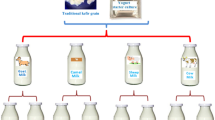Abstract
Kefir grains originate from the Caucasus region and are used for preparing beverages using sugar solution, milk, and fruit juice. As long as they are formed by a microbial consortium useful in the intestine, the produced drinks can be called probiotics. The aim of this study was to determine the antimicrobial activity during kefir fermentation in sugar broth. Fermentations with three kinds of carbohydrates (molasses, demerara sugar, and brown sugar) as carbon source were carried out. Brown sugar promoted the greatest antimicrobial activities, producing inhibition halos corresponding to 35, 14, 12, 14, and 14 mm for Candida albicans, Salmonella typhi, Shigella sonnei, Staphylococcus aureus, and Escherichia coli, respectively. Different carbon source concentrations and the time of fermentation influenced the size of the inhibition halos of the pathogenic microorganisms.



Similar content being viewed by others
References
Santos, A., San Mauro, M., Sanchez, A., Torres, J. M., & Marquina, D. (2003). Systematic and Applied Microbiology, 26, 434–437. doi:10.1078/072320203322497464.
Harta, O., Iconomopoulou, M., Bekatorou, A., Nigam, P., Kontominas, M., & Koutinas, A. A. (2004). Food Chemistry, 88, 237–242. doi:10.1016/j.foodchem.2003.12.043.
Plessas, S., Trantallidi, M., Bekatorou, A., Kanellaki, M., Nigam, P., & Koutinas, A. A. (2007). Food Chemistry, 105, 187–194. doi:10.1016/j.foodchem.2007.03.065.
Loretan, T., Mosert, J. F., & Viljoen, B. C. (2003). South African Journal of Science, 99, 92–94.
Marquina, D., Santos, A., Corpas, I., Muñoz, J., Zazo, J., & Peinado, J. M. (2002). Letters in Applied Microbiology, 35, 136–140. doi:10.1046/j.1472-765X.2002.01155.x.
Rivière, J. W. M., & Kooiman, P. (1967). Archives of Microbiology, 59, 269–278. doi:10.1007/BF00406340.
Garrote, G. L., Abraham, A. G., & Antoni, G. L. (1997). Lebensmittel-Wissenschaft und-Technologie, 30, 77–84.
Paraskevopoulou, A., Athanasiadis, I., Blekas, G., Koutinas, A. A., Kanellaki, M., & Kiosseoglou, V. (2003). Food Hydrocolloids, 17, 615–620. doi:10.1016/S0268-005X(02)00122-4.
Witthuhn, R. C., Schoeman, T., & Britz, T. J. (2005). International Dairy Journal, 15, 383–389. doi:10.1016/j.idairyj.2004.07.016.
Simova, E., Beshkova, D., Angelov, A., Hristozova, T., Frengova, G., & Spasov, Z. (2002). Journal of Industrial Microbiology & Biotechnology, 28, 1–6.
Farnwork, E. R. (2005). Food Science & Technology, 2(1), 1–17.
Gumez, C., & Goven, A. (2003). Food Science & Technology International, 9(5), 365–369. doi:10.1177/1082013203039252.
Pal, V., Jamuna, M., & Jeevaratnam, K. (2005). Journal of Culture Collections, 4, 53–60.
Jamuna, M., & Jeevaratnam, K. (2004). Journal of General and Applied Microbiology, 50, 79–90.
Zubillaga, M., Weill, R., Postaire, E., Goldman, C., Caro, R., & Boccio, J. (2001). Nutrition Research, 21, 569–579. doi:10.1016/S0271-5317(01)00281-0.
UNICEF. (2007). Sobrevivência Infantil. Halteras Press, p. 126.
Curlian, L.V. (1983). National Feed Igredientes, pp. 1–11.
Mendonça, C. R., Rodrigues, R. S., & Zambiazi, R. C. (2000). CieÃncia Rural, 30(6), 1053–1058. doi:10.1590/S0103-84782000000600022.
AOAC (1998). Official methods of analysis.(16th ed.). Arlington, VA: Association of Official Analytical Chemists.
Sreeramulu, G., Zhu, Y., & Knol, W. (2000). Journal of Agricultural and Food Chemistry, 48, 2589–2594. doi:10.1021/jf991333m.
Dornelles, A. S., & Rodrigues, S. (2005). In: Simpósio Nacional de Bioprocessos, Conference Proceedings; Recife, Brazil, 2005, pp. 1–7.
Fagundes Neto, U., & Scaletsky, I. C. A. (2000). Sao Paulo Medical Journal, 118(1), 21–29. doi:10.1590/S1516-31802000000100006.
Alcoba-Flórez, J., Pérez-Roth, E., González-Linares, S., & Méndez-Álvarez, S. (2005). International Microbiology, 8, 133–136.
Bremer, P. J.; Fletcher, G.; Osborne, C. (2004). New Zealand for Crop and Food Researcher Limited, pp. 1–6.
Vieira, J. D. G., Ribeiro, E. L., Campos, C. C., Pimenta, F. C., Toledo, O. A., Nagato, G. M., et al. (2005). Revista da Sociedade Brasileira de Medicina Tropica, 38(5), 383–386.
Bailey, A., Wadsworth, E., & Calderone, R. (1995). Infection and Immunity, 63(2), 569–572.
Greenwalt, C. J., Ledford, R. A., & Steinkraus, K. H. (1998). Lebensmittel-Wissenschaft + [i.e. Und] Technologie. Food Science + Technology. Science + Technologie Alimentaire, 31, 291–296. doi:10.1006/fstl.1997.0354.
Lima, A. S., Rodrigues, S. A., Xavier Filho, L., Batista, R. A., & Santos Júnior, R. J.(2005). Simpósio Nacional de Bioprocessos, Conference Proceedings. Recife, Brazil, pp. 1–7.
Acknowledgments
The authors thank Fundação de Amparo a Pesquisa do Estado de Sergipe (FAP-SE) for the financial support of this study.
Author information
Authors and Affiliations
Corresponding author
Rights and permissions
About this article
Cite this article
Silva, K.R., Rodrigues, S.A., Filho, L.X. et al. Antimicrobial Activity of Broth Fermented with Kefir Grains. Appl Biochem Biotechnol 152, 316–325 (2009). https://doi.org/10.1007/s12010-008-8303-3
Received:
Accepted:
Published:
Issue Date:
DOI: https://doi.org/10.1007/s12010-008-8303-3




